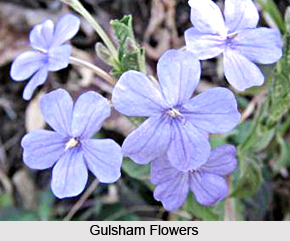 Gulsham or Eranthemum roseum R. Br is quite a tall shrub that rises to a height of 1.8 m and its botanical synonym is Daedalacanthus roseus T. Anders. This shrub is known by different names throughout India. Gulsham is its Hindi name. In Marathi, the Indian medicinal shrub is Dasamuli, Das-Muli or Gulsham and in Tamil, the shrub is called Nilamulli. The leaves of the shrub are opposite, oblong-lanceolate and these narrow down to a slender point. The leaves have a length of 12 to 20 cms and a width of 3.8-7.5 cms. The leaves are lineolate on both sides and the margins entire or crenulate, besides the base tapering into petiole.
Gulsham or Eranthemum roseum R. Br is quite a tall shrub that rises to a height of 1.8 m and its botanical synonym is Daedalacanthus roseus T. Anders. This shrub is known by different names throughout India. Gulsham is its Hindi name. In Marathi, the Indian medicinal shrub is Dasamuli, Das-Muli or Gulsham and in Tamil, the shrub is called Nilamulli. The leaves of the shrub are opposite, oblong-lanceolate and these narrow down to a slender point. The leaves have a length of 12 to 20 cms and a width of 3.8-7.5 cms. The leaves are lineolate on both sides and the margins entire or crenulate, besides the base tapering into petiole.
Gulsham has some blue or rose-coloured flowers and the flowers have a strong, fetid odour. The flowers are borne in linear, lax, axillary and terminal spikes that are upto 15 cm long. The bracts have a length of 1.6 cm and the white coloured bracts are obovate with very prominent raised green nerves. The fruit or capsule of the shrub is 1.3 cm long, clavate and they are pointed and glabrous. Gulsham shrub has numerous seeds that have a diameter of 3-4 mm and they are hygroscopically hairy. As a result, the seeds are densely on the margins. The shrub usually bears flowers from November to January in Central India.
Gulsham shrub is most commonly found in the moist, shaded forest habitats in the western and southern regions of peninsular India. It is also found from northern Maharashtra to Karnataka and Tamil Nadu. The only medicinal property that the shrub has is the spindle-shaped, tuberous root that is a popular remedy for leucorrhoea. Gulsham shrub is generally taken by boiling it with milk.
This is a stub article. You can enrich by adding more information to it. Send your write-ups to content@indianetzone.com.



















